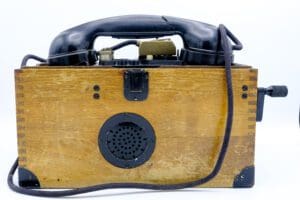The Journey from Radios to Digital Push-to-Talk
Connecting frontline teams with real-time voice is critical, but many organizations struggle to connect deskless workers with team members, management, and the operations center. It is difficult to serve clients and partners when communication breaks down.
Push-to-talk (PTT) technology was introduced roughly 80 years ago with the invention of radio transceivers. With radio transceivers, people could talk to each other across long distances using a mobile device. Push-to-talk technology is simple: users press and hold a button on a handheld device to talk, then let go to listen, instantly transmitting messages to one or many people. 

PTT revolutionized communications during World War II, enabling military leaders to communicate to their troops. Today, industries from hospitality and manufacturing to transportation, retail, and security all rely on push-to-talk technology to communicate with deskless workers. Deskless workers are constantly moving throughout their work days and are more difficult to reach than workers who can consistently be found at their desks.
Historically, push-to-talk communication was voice-only, but today the technology includes more intelligence. Modern push-to-talk platforms connect frontline teams with corporate systems and third-party internet services to provide real-time intelligence, enabling deskless workers to better serve customers and perform important tasks.
Radios: The Origin of Push-to-Talk
Traditional push-to-talk solutions include two-way radios that require users to purchase and set up their own network equipment and apply for operating licenses. Radios have significant challenges:
- They are limited to small usage/reception areas, making it difficult for decentralized and distributed workforces in industries like transportation, where vehicles and drivers are constantly on the move. In these decentralized and distributed industries, workers need to maintain real-time voice communication with dispatch and operation centers.
- Radios can’t tell dispatchers where drivers or assets are, which vehicles are in motion, or who’s online and listening.
- With radios, incidents and emergency situations like incapacitations, location breaches, panic alarms — even fires — require manual processing of events and responses. Radios cannot provide automatic safety check-ins, monitoring for incapacitation, and automatic emergency workflows including all-call notifications, notifying headquarters, and enabling bots to begin running safety procedures.
- Radios can only provide voice communications. Deskless workers often need to send texts, photos, videos, and PDFs while they’re on the job. Being able to send these file types improves communication, reporting, compliance, and productivity.
Walkie-Talkies: More Suitable for Homes than Businesses
Consumers are often familiar with push-to-talk walkie-talkies, which look and operate much like two-way radios but are built with less powerful technology. Walkie-talkies typically fail quickly in business settings because of extremely short communications range, unstable audio quality, and other limitations similar to two-way radios.
Push-to-Talk Apps: The Simple Digital Solution
One recent push-to-talk solution is a simple push-to-talk app for workers’ phones. The app enables users to communicate via push-to-talk using their own cellular or Wi-Fi connection. While they can be convenient, these apps don’t offer encryption or specialized functions that professional organizations need.
Push-to-Talk Platforms
Push-to-Talk platforms solutions deliver more functionality than radios or simple PTT apps. With these platforms, workers can:
- Communicate over any network and any distance without installing special network equipment or applying for licenses.
- Share texts, photos, videos, and files in addition to voice messages.
- Enable mapping and real-time location services so everyone knows where all team members are.
PTT platforms are a huge step forward from radios, but they still lack automation, intelligence, and analytics to help optimize frontline operations.


Push-to-Talk 2.0
Push-to-talk 2.0 (PTT 2.0) is powered by Voice AI Bots and platform integrations to digitize, optimize, and power frontline operations. In addition to voice communication and all the benefits of a PTT platform (multimedia sharing, real-time mapping, etc.), PTT 2.0:
- Provides value-added services like real-time bi-directional language translation and transcription.
- Voice-automates routine work to make frontline teams more productive.
- Calls for help in emergencies, automates safety check-ins, monitors for incapacitation, and tracks geofence location breach alerts. Always-ready Emergency Response Bots listen for voice commands and create multi-step workflows to intelligently manage and coordinate complex actions across teams during an emergency.
- Automates previously manual procedures like pre-ride vehicle inspections and radio checks required for safety and compliance, eliminating manual radio checks.
- Utilizes Process Automation Bots for voice-activated checklists, standard operating procedures, and compliance forms. These voice-automated processes ensure completion on time, in the right order, by the right staff.
- Augments employee intelligence with Voice Bots that have instant access to knowledge bases. Workers can access information dynamically (e.g. employee request), or it can be automatically triggered (e.g., event, geofence breach, etc.) or intelligently routed (e.g., data- or application-driven, IoT sensor alerts, etc.) to deliver the utmost value to the frontline worker.
PTT 2.0 technology has standard end-to-end encryption and can be deployed over public networks, private cloud networks, or onsite at a specific set of locations.
PTT 2.0 Use Cases
PTT 2.0 can benefit organizations of any size, but it’s critical for companies with large frontline teams that require reliable communication. It is a voice-first communication method, so deskless workers can communicate without stopping what they are doing or moving to a different location. It is easy to activate and enables quick, efficient communication with one person or an entire team. If supporting documents are required, workers can attach documents, images, or any additional information the team needs.
PTT 2.0 also provides real-time employee mapping to improve employee safety. You can improve workflows and processes using PTT 2.0 analytics and save time during emergencies with automated safety protocols.
Some examples include:
- Security operations officers and dispatchers use push-to-talk to communicate quickly as they protect the physical security of a worksite. This webinar examines how security teams use push-to-talk.
- On-call transportation and delivery vehicle fleets coordinate via push-to-talk to dynamically dispatch pickups of people or packages. With PTT, drivers can stay hands-free and don’t have to stop to make phone calls or send text messages.
- Retail workers use push-to-talk to help customers find the perfect product by querying inventory with voice commands instead of disappearing to search for what’s in stock.
- Hospitality teams keep hotels and resorts running smoothly, using push-to-talk to coordinate all their teams and delight their guests with great service. Learn how The Boca Raton uses PTT 2.0 to provide frontline communications across various departments, including housekeeping, engineering, food and beverage, security, events, recreation, and concierge.
- Defense organizations use advanced push-to-talk capabilities to coordinate their field teams and improve situational awareness. This video presentation demonstrates how they do it.
What to Look For in a Push-to-Talk Service Provider
The best PTT service providers will help your organization modernize its communication platform and build a path to innovation and digital transformation.
You can evaluate critical PTT features in this Buyers Guide, including all the basic and advanced functionality you should consider, such as:
- Coverage (communications range) and audio quality
- Security and encryption
- Multimedia message support
- Device support and interoperability
- Deployment options
- Automation
Real-time communication, collaboration, and engagement are essential to ensure worker safety, improve productivity and customer satisfaction. Push-to-Talk 2.0 delivers the connectivity and collaboration you need to optimize operations, improve safety, and enhance customer satisfaction.